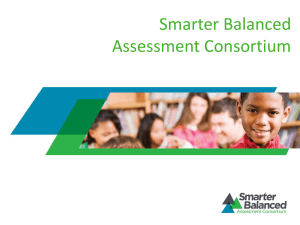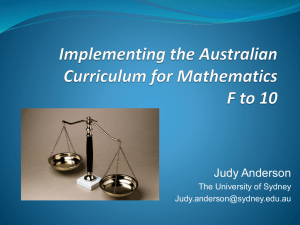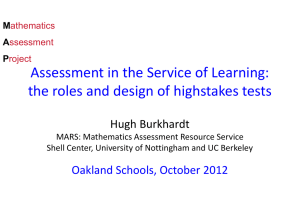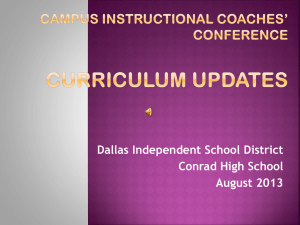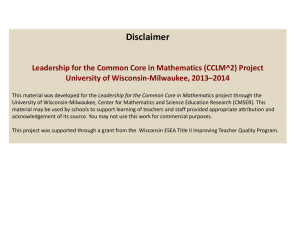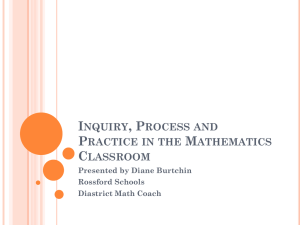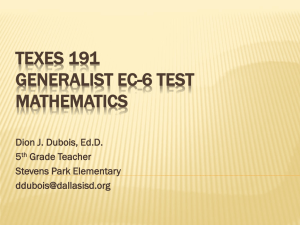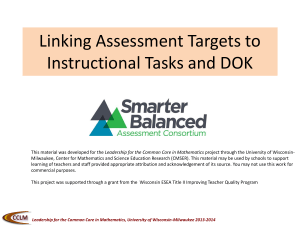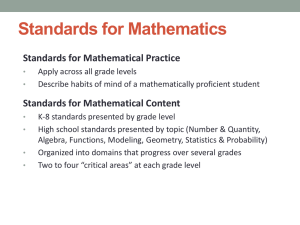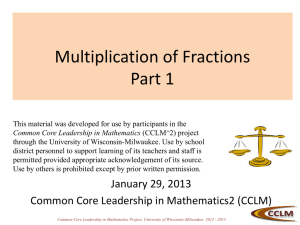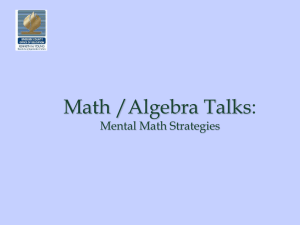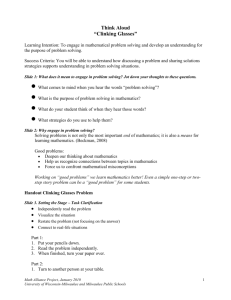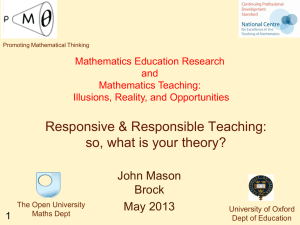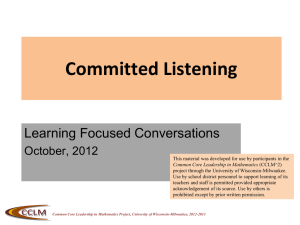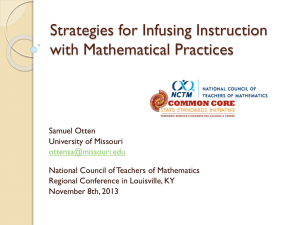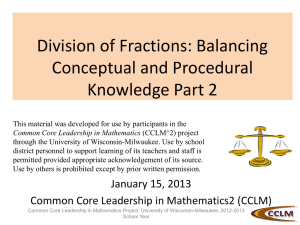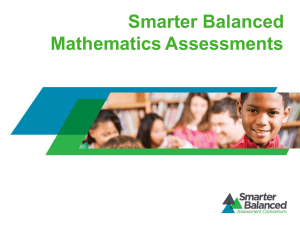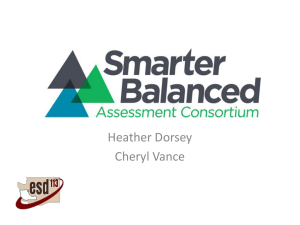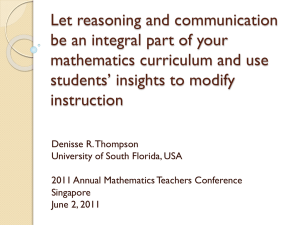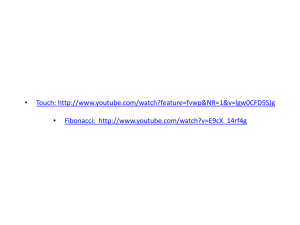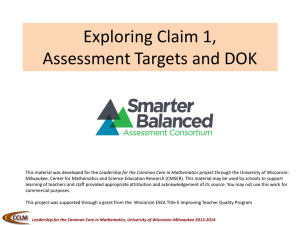Exploring Claim 2, 3, and 4 Part 2
advertisement
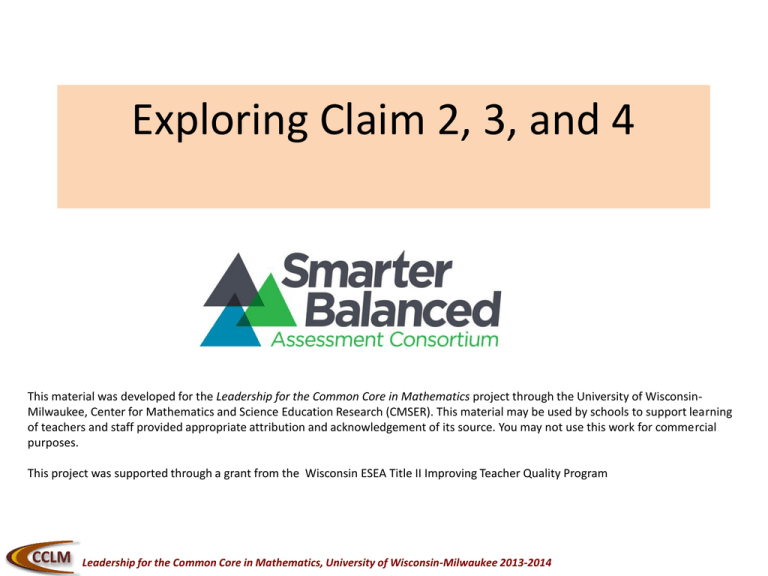
Exploring Claim 2, 3, and 4 This material was developed for the Leadership for the Common Core in Mathematics project through the University of WisconsinMilwaukee, Center for Mathematics and Science Education Research (CMSER). This material may be used by schools to support learning of teachers and staff provided appropriate attribution and acknowledgement of its source. You may not use this work for commercial purposes. This project was supported through a grant from the Wisconsin ESEA Title II Improving Teacher Quality Program Leadership for the Common Core in Mathematics, University of Wisconsin-Milwaukee 2013-2014 Today’s Learning Targets By the end of the session, participants will: • Understand the assessment targets in Claim 2, 3, and 4. • Understand the Depth of Knowledge (DOK) Levels and the Standards for Mathematical Practice in Claims 2, 3, and 4. Leadership for the Common Core in Mathematics, University of Wisconsin-Milwaukee 2013-2014 Smarter Balanced Claims 1. Concepts and Procedures Students can explain and apply mathematical concepts and interpret and carry out mathematical procedures with precision and fluency. 2. Problem Solving Students can solve a range of complex well-posed problems in pure and applied mathematics, making productive use of knowledge and problem solving strategies. 3. Communicating Reasoning Students can clearly and precisely construct viable arguments to support their own reasoning and to critique the reasoning of others. 4. Data Analysis and Modeling Students can analyze complex, real-world scenarios and can use mathematical models to interpret and solve problems. SBAC 2011, p.17 Leadership for the Common Core in Mathematics, University of Wisconsin-Milwaukee 2013-2014 Assessment Target Sort Label three post-its, one for each Claim (2,3,4) Select one Assessment Target from the envelope. Discuss the Target. Place that Assessment Target under the appropriate Claim. Repeat! Leadership for the Common Core in Mathematics, University of Wisconsin-Milwaukee 2013-2014 SBAC Claim 2 Problem Solving: Students can solve a range of complex, well-posed problems in pure and applied mathematics, making productive use of knowledge and problem-solving strategies. Grades 3-8 Targets • A: Apply mathematics to solve well-posed problems arising in everyday life, society, and the workplace. • B: Select and use appropriate tools strategically. • C: Interpret results in the context of a situation. • D: Identify important quantities in a practical situation and map their relationships (e.g., using diagrams, twoway tables, graphs, flowcharts, or formulas). Leadership for the Common Core in Mathematics, University of Wisconsin-Milwaukee 2013-2014 About Claim 2 Rationale for Claim 2 makes it clear that evidence for it needs to include demonstration of actual application of problem solving. These tasks could present non-routine problems where a substantial part of the challenge is in deciding what to do and which mathematical tools to use. Leadership for the Common Core in Mathematics, University of Wisconsin-Milwaukee 2013-2014 SBAC Claim 3 Communicating Reasoning: Students can clearly and precisely construct viable arguments to support their own reasoning and to critique the reasoning of others. • A: Test propositions or conjectures with specific examples. • B: Construct, autonomously, chains of reasoning that will justify or refute propositions or conjectures. • C: State logical assumptions being used. • D: Use the technique of breaking an argument into cases. • E: Distinguish correct logic or reasoning from that which is flawed and—if there is a flaw in the argument—explain what it is. • F: Base arguments on concrete referents such as objects, drawings, diagrams, and actions. • G: At later grades, determine conditions under which an argument does and does not apply. (For example, area increases with perimeter for squares, but not for all plane figures.) Leadership for the Common Core in Mathematics, University of Wisconsin-Milwaukee 2013-2014 About Claim 3 The set of Claim 3 tasks may involve more than one domain. As evidence, students are expected to produce evidence of their own reasoning and the reasoning of others. Claim 3 tasks may involve assessment targets from an earlier grade. Leadership for the Common Core in Mathematics, University of Wisconsin-Milwaukee 2013-2014 SBAC Claim 4 Modeling and Data Analysis: Students can analyze complex, realworld scenarios and can construct and use mathematical models to interpret and solve problems • A: Apply mathematics to solve problems arising in everyday life, society, and the workplace. • B: Construct, autonomously, chains of reasoning to justify mathematical models used, interpretations made, and solutions proposed for a complex problem. • C: State logical assumptions being used. • D: Interpret results in the context of a situation. • E: Analyze the adequacy of and make improvements to an existing model or develop a mathematical model of a real phenomenon. • F: Identify important quantities in a practical situation and map their relationships (e.g., using diagrams, two-way tables, graphs, flowcharts, or formulas). • G: Identify, analyze, and synthesize relevant external resources to pose or solve problems. Leadership for the Common Core in Mathematics, University of Wisconsin-Milwaukee 2013-2014 Abut Claim 4 In Claim 4, a key feature of items and tasks is that the student is confronted with a contextualized, or real world situation and must decide which information is relevant and how to represent it. Items in Claim 4 are not yet fully formulated (well-posed) in mathematical terms. Leadership for the Common Core in Mathematics, University of Wisconsin-Milwaukee 2013-2014 Reflection: What? So What? Now What? • Understand the assessment targets in Claim 2, 3, and 4. • Understand the Depth of Knowledge (DOK) Levels and the Standards for Mathematical Practice in Claims 2, 3, and 4. What have you learned? What actions will you take based on what you have learned about all 4 Claims? Leadership for the Common Core in Mathematics, University of Wisconsin-Milwaukee 2013-2014

